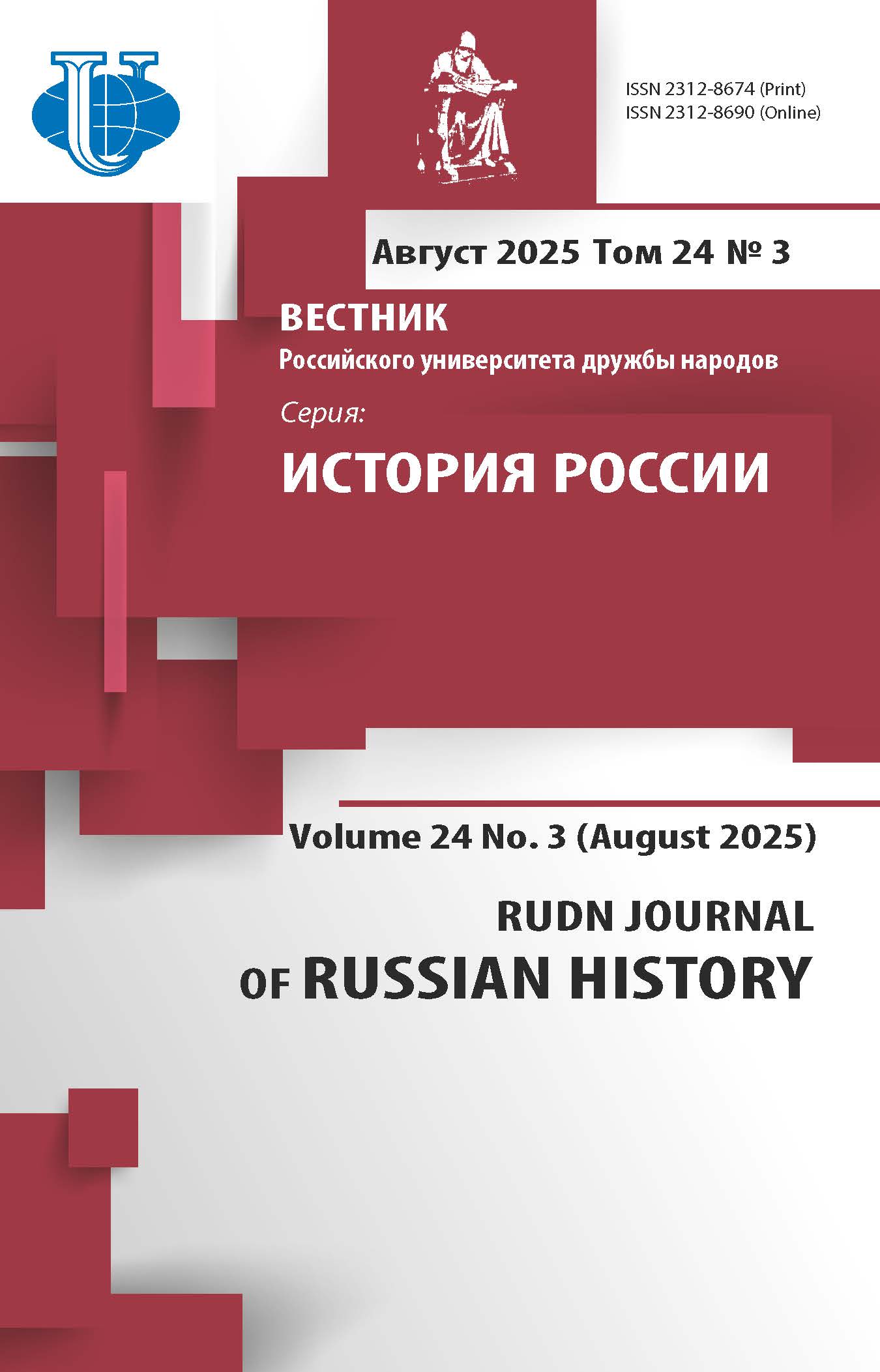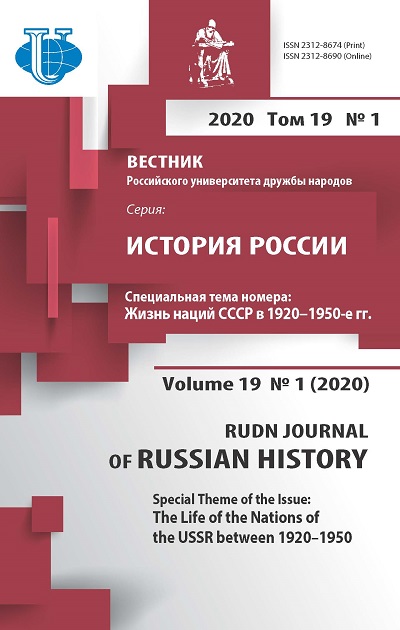In this issue
- Authors: Brandenberger D.L1, Blitstein P.A.2
-
Affiliations:
- University of Richmond
- Lawrence University
- Issue: Vol 19, No 1 (2020): THE LIFE OF THE NATIONS OF THE USSR BETWEEN 1920-1950
- Pages: 8-15
- Section: IN THIS ISSUE
- URL: https://journals.rudn.ru/russian-history/article/view/22982
- DOI: https://doi.org/10.22363/2312-8674-2020-19-1-8-15
- ID: 22982
Cite item
Full text / tables, figures
Abstract
-
Full text / tables, figures
The study of the Soviet Union as a multinational state and society has made considerable strides since 1991, a consequence of the availability of new archival sources, the careful work of Russian scholars at the center and in the regions, and the contributions of Western specialists. As the articles published in this issue attest, the range of themes and theoretical and methodological approaches are such that it is difficult to categorize all of this work together. Broadly speaking, however, we can divide the work presented here into two clusters - that which seeks to understand developments in the Soviet Union as a whole (Blitstein, Brandenberger, Kaplan) and that which traces developments in particular republics and regions (Kamenskikh, Almaev, Uvarov, Seay). Burnasheva and Ignat’eva’s piece reveals the ways in which these two possibilities might be fruitfully joined through the study of one individual.
Mikhail S. Kameskikh’s article on the formation of the Komi-Permiak Autonomous Region reveals a story that is consistent with research on other regions of the Soviet Union in its early years. The establishment of national regions and republics, and their boundaries, were the site of fierce political struggle between advocates of nationality policy and other, primarily regional economic, interests, which the author describes as “cynical and uncompromising.” Here the center played a mediating role and, perhaps because of its weakness in the early 1920s, could not always make its impact felt. What is especially notable in Kamenskikh’s research is the fact that authorities in the Komi region itself strongly supported the formation of a distinctive Komi-Permiak region, an intervention which would have been unacceptable later in the decade, let alone the 1930s.
Rustam Z. Almaev picks up on themes discussed in Kamenskikh’s article in order to examine the flip-side to Soviet nationality policy and indigenization - the national purges that struck non-Russian regions between 1937 and 1938. Almaev notes that charges of “bourgeois nationalism” were common in Bashkiriia during these years within the sphere of education for three reasons. First, teachers and education officials were targeted for advancing the teaching of the Bashkir language, literature and culture at the expense of the Russian language, literature and culture. This occurred at a time when emphasis on Russian-language instruction, and Russocentrism generally, was on the rise. Second, Bashkir party members, representatives of the intelligentsia and others were denounced for past association with local political organizations associated with the Jadid movement or Sultan Galiev, charges consistent with developments in other national republics and regions. Third, many local party and state officials were charged with “bourgeois nationalism” for otherwise unremarkable administrative transgressions, which usually amounted to generic abuse of authority or a failure to meet plan targets. In other words, in each case, close attention to the charges reveals that none of the alleged infractions were either “bourgeois” or “nationalist,” per se, and only a fraction were linked in any way to actual violations of Soviet nationality policy. “Bourgeois nationalism” instead became a code word for regional, non-Russian deviation from central party and state diktat.
At first glance, Sergei N. Uvarov’s study of family and marriage patterns in Udmurti- ia between the 1939 and 1959 censuses, might not seem clearly connected to our themes. Relying on census data, including unpublished archival materials, he discovers both the expected - a significant impact of the Great Patriotic War on all demographic indicators, the growing disparities between rural and urban families - and the perhaps unexpected increase in births outside of marriage; given the fact the Udmurt population remained more rural at this time, this might be a notable fact worth further attention. His work reminds us both that long-term trends affected all nationalities, and that the War itself did.
Nicholas Seay’s article on the first two generations of Tadzhik writers is the one piece of this first group that examines a nation outside the Russian Federation and represents, with Isabelle Kaplan’s article, a focus on the arts and culture. In some ways, the story of the emergence of a Tadzhik literary intelligentsia is unusual in the Soviet context, in that it required the invention of a new identity and the support of a writer - Lahuti - who was Iranian and internationalist, rather than Central Asian, per se. Yet it is also consistent with a more typical Soviet story in which the second generation of the republican intelligentsia, which was raised by Soviet power, produced (or, was required to produce) national cultures which were bounded and autochthonous. Only Tadzhik, rather than “Irano-Tadzhik,” literature would fit into the model of a Friendship of Peoples that was bounded by the Soviet state.
According to Isabelle Kaplan, the USSR’s commitment to the Friendship of the Peoples was epitomized by the dekady of national art that stretched from 1936-1940. These 10-day events, celebrating everything from Ukrainian to Azerbaijani culture, contributed in Kaplan’s view simultaneously to the cause of Soviet unity and diversity. First, the dekady hybridized the Soviet cultural scene and contributed to internationalist nation-building efforts by bringing republican culture to Moscow and the all-union press. Second, the dekady demonstrated the persistence of Soviet priorities oriented around ethnic differentiation and the Friendship of the Peoples by staging the dekady’s celebration of the non-Russian arts in unapologetically vernacular forms. Ultimately, the stress that the party leadership placed on the dekady indicates to Kaplan that the party leadership spent the last years before the war reiterating its commitment to internationalist values to a degree previously unappreciated in the scholarship.
According to Peter Blitstein, Soviet interwar nationality policy is best assessed in comparative context, insofar as the USSR confronted the challenges of ethnographic and cultural diversity alongside the rest of the industrial and developing colonial world at the outset of what is often called the era of mass politics. He notes that such comparative analysis yields intriguing results, especially if examined over time. When the USSR is considered in relation to other states in Eastern Europe, Soviet nationality policy appears during the 1920s to have stressed diversity and the promotion of minority identities at a time when many of the USSR’s neighbors were pursuing nationalizing policies at the expense of minority populations. That said, such Soviet policies of ethnic differentiation should be seen as distinct from similar British and French colonial policies, which also stressed ethnographic, cultural and racial differences, insofar as the Soviet leadership intended the USSR to function as an integral, unified state rather than an empire. Toward the end of the interwar period, these Soviet tendencies toward the creation of a more integral, unified state led the USSR to embrace policies that were increasingly more reminiscent of its East European neighbors, although more nationalizing in form and function than actually nationalist.
In RUDN Journal of Russian History’s interview with David Brandenberger about the second Russian edition of his book, Stalinist Russocentrism, he discusses his analysis of the USSR’s “search for a usable past” under Stalin. He argues that between the 1930s and the 1950s, the party leadership sought to improve the USSR’s capacity to mobilize its population for industrialization and war. Tracing a series of shifts in official propaganda campaigns during the interwar period, Brandenberger explains how a series of false starts and failures led the USSR to co-opt heroes, myths and legends from pre-revolutionary Russian history in the name of popular mobilization. Focusing on an apparent about-face from Marxist internationalism to Russian nationalism, he examines the nature of this official russocentrism within the party elite, its dissemination via mass culture, and the popular resonance that it elicited in society at large. An analysis of mobilizational propaganda, rhetoric and sloganeering, Stalinist Russocentrism also illustrates the key role that this coup played in the formation of Russian national identity at midcentury.
It is interesting to note how Blitstein and Brandenberger differ in their analysis of the russification of the USSR during the 1930s. Blitstein understands the emergence of russocentrism as part of a long-term modulation in Soviet nationality policy that began with early endorsement of ethnographic differentiation before shifting toward russification in language, schooling and cultural policy. Extending the work of other historians such as Yuri Slezkine, Francine Hirsch, and Terry Martin, Blitstein suggests that this nationalization was a broad, unified, long-term program of administrative centralization that at its core aimed to extend the reach of the modern state. Brandenberger, by contrast, sees the russification of Soviet propaganda and self-representation to be a more contingent policy development linked to the politics of social mobilization rather than to the more institutional contours of nationality policy. In Brandenberger’s view, russocentrism in Soviet propaganda and self-representation was not inherently connected to russification in language and educational policy and was much more of an ad hoc exigency than the administrative reforms that Blitstein and others detail.
The relationship between the pieces by Blitstein, Brandenberger and Kaplan is also worthy of mention. Kaplan argues in her piece that the dekady celebrating non-Russian republican culture testify to a continuing commitment to internationalism and ethnic differentiation in Soviet nationality policy toward the end of the interwar period. Her work harmonizes well with that of Blitstein, insofar as he too sees the USSR as capable of maintaining a commitment to ethnic diversity between 1936-1940 despite the increasing priority afforded to russification in other areas. For Brandenberger, Kaplan’s dekady are indicative of something else entirely - the newly tokenistic Orientialization of non-Russian culture in the USSR during a period of increasing russocentric ascendency. Russocentrism, in Brandenberger’s mind, linked Stalinist state and society to the prerevolutionary political, cultural and artistic accomplishments of the Russian people and reduced the non-Russian contribution to Soviet culture to an ornamental one - in this case, the dekady - stripped of its political history and independent trajectory. How and whether this Orien- talization could be compatible with the celebration of ethnic differences emphasized by Kaplan and Blitstein would be a problem for the postwar decades.
How to bridge the distance between all-union studies like those of Blitstein, Brandenberger, and Kaplan, with work on the individual nations of the Soviet Union remains a thorny problem for studies of the multiethnic Soviet Union. Natalia N. Bur- nasheva and Vanda B. Ignat’eva’s article on M.K. Ammosov represents one possible answer to this problem. Ammosov was one of the few non-Russian Communist officials to be posted outside of their home region in this period, and his impact on the history of Kazakhstan is especially notable. Readers will decide for themselves whether Ammosov should be credited with developing a distinctive approach to Soviet regional economic development in tension with the central planning favored by the Stalinist state. Yet Burnasheva and Ignat’eva’s focus on a notable individual should be seen as a possible model for fruitful research on the Friendship of Peoples that takes into account the particularities of individual nations of the Soviet Union.
About the authors
David L Brandenberger
University of Richmond
Author for correspondence.
Email: dbranden@richmond.edu
PhD in History, Professor of Russian and Soviet History in the Department of History, University of Richmond (USA); research associate, National Research University “Higher School of Economics”
28 Westhampton Way, Richmond VA 23173 USAPeter A. Blitstein
Lawrence University
Email: peter.a.blitstein@lawrence.edu
PhD in History, Associate Professor of History at the Department of History
711 E Boldt Way, Appleton, WI 54911 USAReferences
Supplementary files















